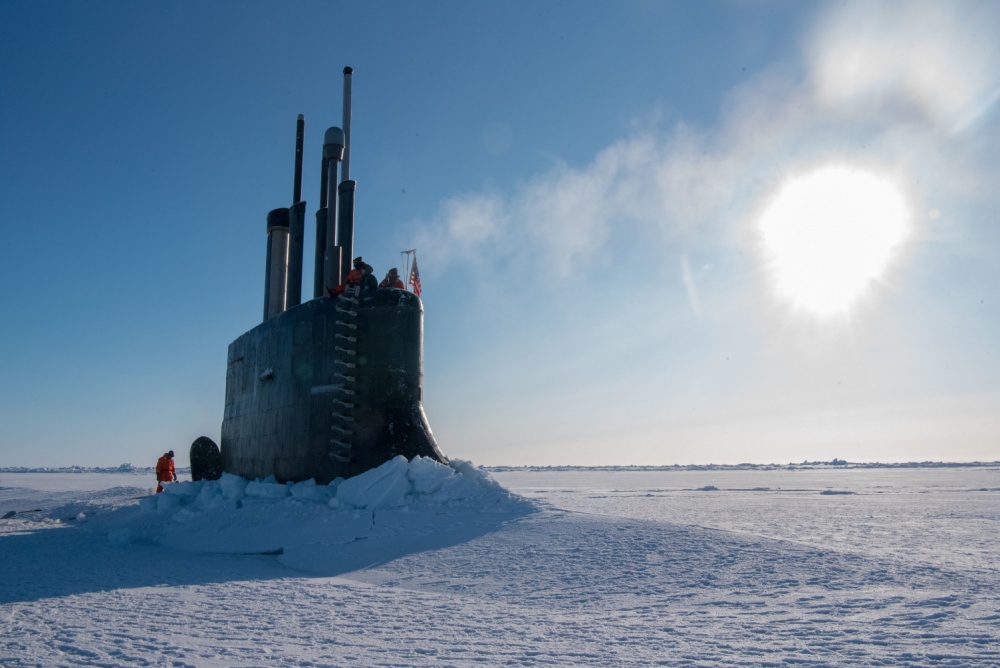Wave technology is one-two punch for ice-breaking
Waves generated by submarines as they move through the water are turning out to be effective icebreakers.

The concept of using a wave to break a solid object is well understood, even by laypeople. Find the right tone and you can make a wine glass, for example, vibrate. Turn up the sound enough and the vibrations become so violent that the glass shatters.
The same concept as a method of icebreaking is much newer; the first theoretical studies date from the late 1960s, when Soviet academics began looking for a better way for submarines to surface through Arctic ice.
Since then, practical experience using these types of waves, known as flexural-gravity waves, to break ice has shifted above the waterline. Starting with the Canadians in the 1970s, the focus has been on using hovercraft to create oscillations in the ice to make it vibrate. As with the wine glass, if the wave has enough energy behind it, the ice can be made to shatter.
While using hovercraft has the benefit of allowing ice-breaking operations in waters that would be too shallow for conventional vessels, such as inlets and rivers, they are not useful if the ice is more than a meter thick, as is often the case in shipping lanes. A hovercraft’s range is also more limited than a traditional icebreaker.
[Can the US benefit from Finland and Russia’s icebreaker expertise?]
For this reason, and because the original motivation for studying flexural-gravity waves still exists scientists are taking another look at underwater wave-generation.
Then, as now, when surfacing through ice, submarines rise gradually until they make contact. If the ice is thin enough, the submarine can break through with a single push. If it is thicker, it must rise and sink repeatedly, until the ice is fractured enough for it to surface (see videos below).
Generating waves when surfacing in ice would have two benefits for submarines. It would give it the opportunity to rise faster, which could be critical in the event of an emergency. It would also mean acting less like an icebreaker. In either case, reducing the amount of contact the submarine has with solid ice when surfacing would reduce the chance of damage.
Building on the original Soviet studies, recent Russian research is looking into whether submarines could employ flexural-gravity waves to break ice from below more efficiently than surface icebreakers. The initial results suggest this may indeed be the case.
[US Coast Guard will get some icebreaker design help from Canada]
If, the theory goes, submarines rising out of ice-covered water can generate waves that can force the ice above to break apart, then they can use them when moving forward to leave behind a clear path in the same way surface vessels do.
The idea has been patented in Russia in several variants. And although experiments remain at the model stage, one of the more recent papers about the method, published in 2017, provides new information about the method.
For example, it finds that altering the speed of the submarine alters how the ice is broken. A slower-moving vessel can leave behind a narrow channel of completely shattered ice. Increasing the speed, while it decreases the effectiveness of the ice-breaking, increases the area affected.
The experiments also showed that water depth plays a key role for determining the speed at which submarines must travel in order to generate a flexural-gravity wave that can break ice.
[US Coast Guard tests new icebreaker designs amid calls for funding]
The advantage of using submarines, it is hoped, is that they could clear a path faster than icebreakers.
Even if this turns out to be the case, breaking ice from below may yet prove impractical. Submarines must travel close to the ice in order for the wave it generates to have an effect. In order to break meter-thick ice, the body of the submarine can be no deeper than 30 meters. To break two-meter ice, it needs to be above 25 metres.
Studies so far suggest flexural-gravity waves generated by submarines cannot break ice that is three meters thick, although further research is required to fully understand how things like variations of the ice cover, water depth, current and underwater features affect their effectiveness.
For now at least, our conception of what an icebreaker is remains intact.